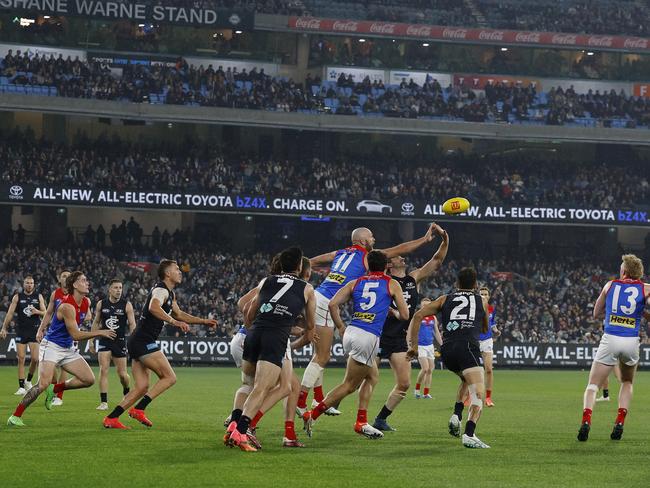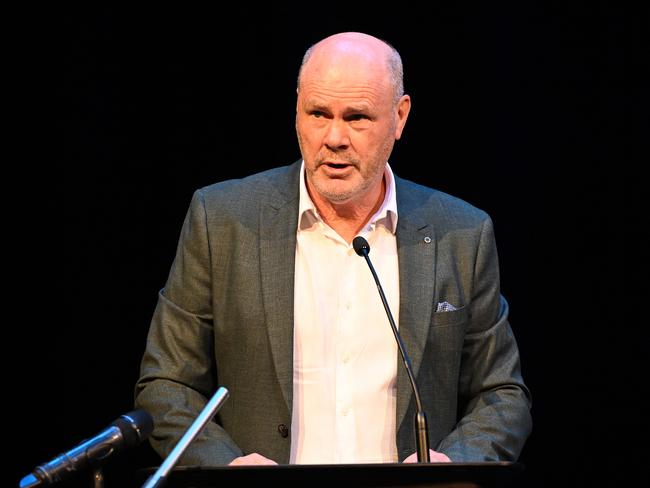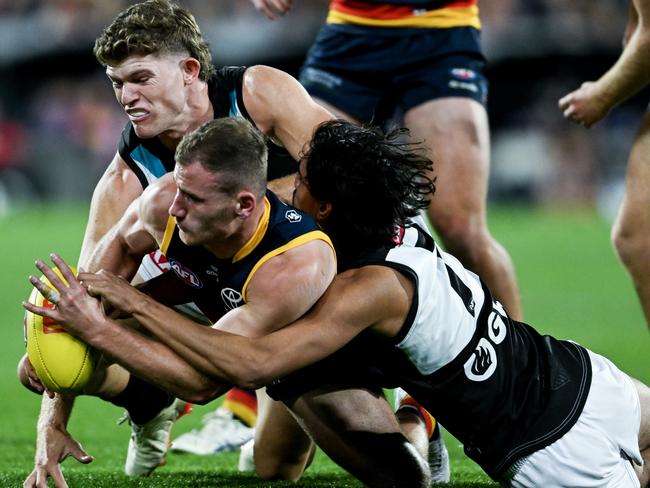Mark Robinson speaks to coaching great Rodney Eade on how to fix the modern game
Despite the introduction of the 6-6-6 and stand rules, the game - once again - is being clogged up. MARK ROBINSON talks to the coach who invented the ‘flood’ on how to fix the modern mess.
AFL
Don't miss out on the headlines from AFL. Followed categories will be added to My News.
The coach who invented the “flood”, Rodney Eade, says the AFL has a problem with player density.
He wants the AFL to get busy before the problem grows and potentially swallows the game.
And he has one definitive message: We have to burst the bubble.
“It’s becoming like Auskick,’’ Eade said, describing the mass of players at stoppages.
“I found footy appealing last year. I thought the start of this year was OK, and now … not really.
“Us old blokes, we like the history of the game, but we are in the entertainment industry now. And if we don’t entertain, our generation of 15-year-olds won’t follow the footy. That’s what I fear. I’m not saying that will happen because crowds are up, but there’s so many other things in life now. They want instant gratification.
“We need a bigger sample size, but we also need to keep an eye on it. Can we see our game becoming more of defensive game like it was three or four years ago.’’
Eade is not too perturbed by the defensive flooding, where often there are 28 players in a defensive 50m, or even 34 players, as there was in the final minutes of Thursday night’s heavily-defensive match between Carlton and Melbourne.

No, he’s not going to bash his invention.
But he says he has a solution to help rid the game of the increased congregation of players at stoppages, which often can become repeat stoppages, and which in turn would help burst the 70m bubble which is the signature ploy of modern footy.
Time and again, full-forwards find themselves on the wings, being dragged high up the ground because of the defensive “press”, which was refined by then Collingwood coach Mick Malthouse, circa 2010 premiership, with the aid of 150-plus interchange rotations.
Rotations have dropped to 75, but the press has not dropped away.
Eade’s proposal, albeit not the first time it has been offered as a solution, would require, for example, a minimum of three pairs of players in each 50m arc at every stoppage to “spread the ground’’.
If not at every stoppage, then at least at every boundary throw-in, with a plan to expand it to every stoppage.
“We came up with the 6-6-6 rule, which helps at the start, and the stand rule, and we’re trying to make the game quicker and the stand rule has worked to a degree,’’ Eade said.
“But the biggest thing which controls the game is still our coaches. They control the game, no matter what rules you put in.’’
Broadly, and despite the 6-6-6 and stand rules, coaches flood the defences and the contests, which means the ball winner has less time to play instinctive footy because with so many players around the ball, instinct is tackled out of them.
The tackling itself has created confusion and frustration around incorrect disposal and coupled with defining “prior opportunity”, the ball is living in contest. “It’s massive,’’ Eade said.
“If you like the 6-6-6, why don’t we have a version of 6-6-6 at every stoppage, at every ball-up and throw-in?’’

Conceding it was a radical idea, he said the field umpire would award a free kick against a player who did not make it “back’’ behind the 50m arc when the ball was ready to be bounced.
“Like the deliberate point, if they aren’t back there, then pay the free kick,” Eade said. If the stoppage is at half-back, it gives the other team a shot at goal. People will jump and down about it to start with, but what will happen is coaches will not direct their forwards to push high up the ground.
“We would encourage more positional play.
“Again, if the stoppage is at half-back, and if you’ve got three players in your forward 50m, you’ll need to have another two or three in between so they can be link players.
“The attacking team will have a couple building a wall anyway, so they will also have a couple of players out. Therefore there’s less density around the stoppages. There will be 12 or so players out of that stoppage area. And there’s probably got to be some players outside of the stoppage but inside in the back 50 to cover that space as well.’’
AFL legend Malcolm Blight agrees partly with Eade.
In 2023, he bemoaned that the sport was suffering as a spectacle because coaches were too preoccupied with tackling and pressure. “Tackling is now a massive part of the game and the numbers will only continue to rise,’’ Blight said. “Kick goals, make it a more exciting game, rather than that congestion game of crap we’ve seen for years.’’
This week, Blight doubled-down with his criticism and also expressed concern about the number of injuries to players this year.
He also offered a similar solution to Eade’s to help fix the game.
“I read somewhere that the Showdown had 82 stoppages and Collingwood-Carlton had 77 stoppages. Is that the game we really want to see in perfect conditions?” Blight asked on SEN.

He said he’d like to see, after a behind was scored, six players back behind the centre square to open up play.
He also said he’d like to reduce interchange rotations from 75 down to 40. “Just make it a bit more tiring so they can’t quite get up and down the ground as quickly,’’ Blight said. “Otherwise, it’s going to be chaos. Injuries will mount and the game will keep getting squeezed.”
Another AFL legend, Leigh Matthews, put on the agenda this season the potential advantage of reduced rotations, in terms of tiring players, which was supported by the deep-thinking former Giants skipper Phil Davis.
On Thursday night, veteran Channel 7 caller Brian Taylor also wondered what potential role less interchange could have on the game. The respected commentator, who has called thousands of matches, expressed his concern when waiting for a blood rule substitution in the Blues-Demons clash.
“How’s the shot there with all the players in that small (area),’’ Taylor said. ‘‘If anyone has got an idea about a rule that can pull players back into roughly other parts of the ground … that’s the shot the AFL would look at and say: How do we cure that?
“There’s got to be a rule out there somewhere without drawing more lines on the ground … maybe it’s less interchange.’’
Eade, however, said beware of the “unintended consequences’’ of limiting player rotations.
“What the coaches would do, they would put more players behind the wall, chip the ball around to save the legs, make it even more boring,’’ he said.
Reminded that there were already players behind the ball, he added: “They will leave them there longer. Fast breaks won’t be as frequent. They already shut down games late in quarters, they will shut the game down for 10 minutes, chip it around and defend with the ball.’’
COACHES ARE TO BLAME
Eade coached 377 games at Sydney, the Western Bulldogs and Gold Coast and said coaches care about the game. “At least up until February, then they start caring about winning games,’’ he said.
He’s not critical of the coaches. “They are paid to win matches for members and for the club and how they do that is how they will be judged. But coaches control the game, so how can we take control out of the coaches?
“The bottom line is most coaches don’t want to be scored against, they don’t want to be scored on turnover, and that’s why scoring is going down again.
“There’s more numbers going back than last year.’’
The genesis of modern-day flooding dawned on Eade when he played schoolboy footy in Tasmania in the early 1970s.
He wondered why when a defender marked the ball at, say, centre half-back, why the forwards couldn’t “push up a little bit” and block any lateral movement, and why the on-ballers couldn’t “drop back’’ and block the leading lanes.
At Sydney, he put his strategy in place. “I just blocked up our defence and opened up space for the big fella (Tony Lockett) we had in the goalsquare,’’ he said. “It was really about how West Coast played with Glen Jakovich and the likes of Guy McKenna, they liked to kick it around the boundary line and they’d have space to play in. It (the flood) just evolved and it happened very quickly.

“But I don’t worry about the flooding, I now worry about numbers around the ball.’’
Outside of starting three pairs inside each of the arcs, Eade had two other solutions.
1) He’d abandon the nomination of ruckmen at stoppage and throw the ball up quicker, and would pay a free kick against a player who went third man-up and;
2) Bring together the umpires, the coaches, players, the AFL and media representatives and ask the umpires: What are the five hardest rules to interpret and how would you like to umpire it?
“We try to make the game more black and white rather than grey’’ he said. ‘‘So, if it’s prior opportunity, we say, ‘OK, that’s good, let’s work at that’.
“Players would adapt, coaches would adapt and we open up the game by having consistent interpretation. Rather than leave it to the coaches, players and through rules committees, people who react on the run, let’s go to the umpires.’’
He believed the shortened pre-season combined with the increased speed in the game, for example, had contributed to the glut of hamstring and soft-tissue injuries.
Carlton had another hamstring injury, to Adam Cerra, on Thursday night, and at Essendon, which is another club beset by soft-tissue problems, Xavier Duursma strained a calf muscle on Wednesday.
“We are asking the players to play quicker, and through the AFLPA they want to start the pre-season later,’’ Eade said. “Technically, some clubs have had four weeks less preparation to condition the players to play the game at a more frenetic pace. We’ve put real stress and strain on player bodies.’’


